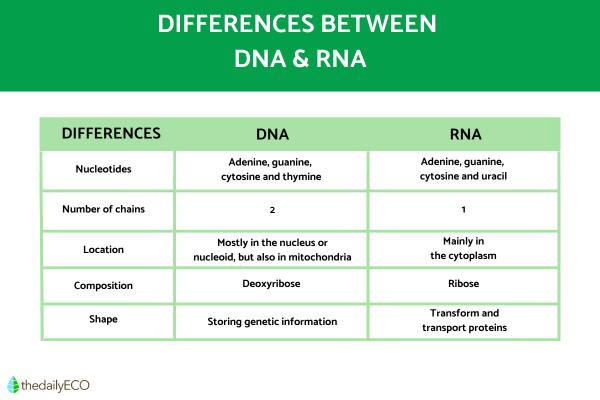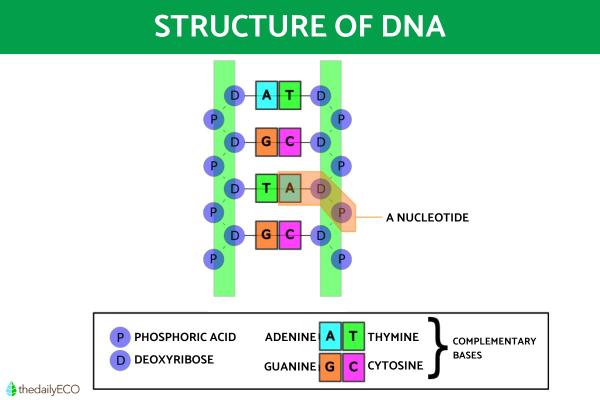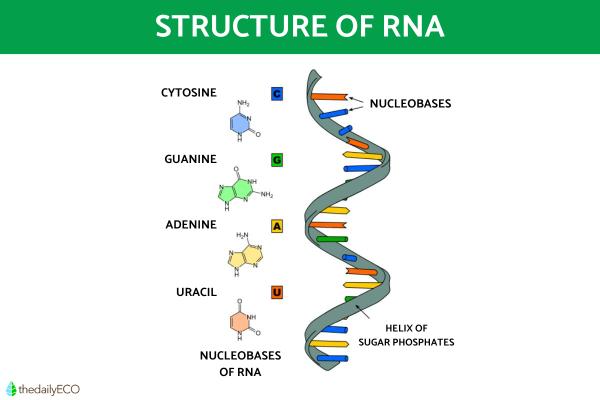
For living organisms to survive, they require various physiological processes and metabolic pathways which influence their physical forms. These processes have been adapted over millions of years of evolution thanks to their ability to pass information on from generation to generation. This information is stored in genetic code, a code with origins at the very beginning of existence. Through empirical investigation and scientific endeavor, we have been able to understand to a great extent how genetic code functions and why it results in the characteristics of different living organisms.
At thedailyECO, we look deeper into how genes process information by looking at the differences between DNA and RNA. We discover what these molecules do and how they function by making a comparison of them. We also show you how they are formed with relevant diagrams.
What is DNA?
Nucleic acids are large molecules made of natural polymers essential for all life on Earth to function. While these nucleic acids were first found in cells with a nucleus (hence their name), they have since also been found in prokaryotic cells which do not have a nucleus. There are two main varieties of nucleic acid, DNA and RNA.
DNA is the molecular structure that stores encoded genetic information. This means it stores all the information necessary for each organism to function. Certain segments of DNA will form the genes, which will encode a particular protein. Ut will not do so alone, but with the help of RNA. We will later explain what RNA is and how it works with DNA. For now, it's important to remember that DNA is the only nucleic acid that stores information in code.
The initials of the macromolecule (i.e. large molecule) are to abbreviate deoxyribonucleic acid, which owes its name to the elements that form it. It is made up:
- A double helix chain of nucleotides: they are made up of one of the four nitrogenous bases (nucleobases) which are adenine, guanine, cytosine and thymine. They are complementary to each other, as we can see when guanine binds with cytosine and adenine binds with thymine. You can see a diagram of DNA double-helix structure below.
- A chain of deoxyribose and a phosphate.
The deoxyribonucleic acid (DNA) molecule is encapsulated in the nucleus of eukaryotic cells in the form of chromosomes and packaged in nucleosomes so that the double strands of DNA can be accommodated in a compact way. In prokaryotic cells, the DNA can be found in the center of the cell in a space known as the nucleoid.
What is the function of deoxyribonucleic acid (DNA)?
This DNA nucleic acid has the main function of storing information, but it also has other functions. For this reason, we can group DNA into two essential parts:
- Coding DNA: this is the part which will be transmitted to the next generations. We can say that DNA is the transmitter of heredity functions.
- Non-coding DNA: it was previously known as junk DNA, but it was discovered that it does have some utility within the cell, with a regulatory and structural function. Some parts of the non-coding DNA are either non-functional or their function has yet to be determined.
To learn more about how information is stored at a cellular level, take a look at our article on the difference between eukaryotic and prokaryotic cells.

What is RNA?
RNA is the abbreviation of ribonucleic acid, a nucleic acid that occurs in eukaryotes and prokaryotes, such as bacteria or viruses. It is stored together with DNA in cells with a nucleus, where it is later released into the cytoplasm. In cells without a nucleus, it is always free in the cytoplasm.
RNA formed by:
- A single spiral chain of ribonucleotides: composed of one of the four nucleobase adenine, guanine, cytosine, and uracil, the latter substituting for thymine in DNA. You can see a diagram of RNA single-helix structure below
- A phosphate and a ribose: like the previous base pairs, they are complementary to each other.
RNA is in charge of interpreting the DNA information coded in the genes to make it functional. This is achieved by transcribing DNA into messenger RNA. This is, in turn, translated into proteins. This is a brief summary so that you understand the basic function of RNA and its relationship with DNA. Let us now take a closer look at the functions of RNA.
What is the function ribonucleic acid (RNA)?
RNA is more versatile than DNA and has several functions. This is because there are different types required to complete its multiple activities. Such types include:
- Messenger RNA (mRNA): this is the product of the transcription of a gene. It is from messenger RNA that a protein will be formed.
- Ribosomal RNA (rRNA): makes ribosomes with the help of proteins, the former being another important cell organelle. To learn more about these components of cells take a look at our article on the definition and function of cell organelles.
- Transfer RNA (tRNA): physically transports manufactured amino acids to the part of the cell where they are needed, as well as assisting in the assembly of proteins.
On the other hand, RNA also catalyzes reactions and regulates gene expression. You can find out how cells create organisms by looking at the differences between plant and animal cells.

Differences between DNA and RNA
Now that we know the definitions of DNA and RNA, as well as their functions within the cell, we can have a better understanding of their differences. Although DNA and RNA are very similar, the following are their most significant differences:
- Nucleobases: RNA has uracil, but DNA substitutes it with thymine. The other nitrogenous bases (adenine, guanine, and cytosine) are the same.
- Number of strands: DNA is a double strand and RNA is a single strand. This means that another of the differences between RNA and DNA is the number of polynucleotides, which in DNA are two and in RNA is one. In DNA, these strands are held together in a famous double helix shape.
- Location: DNA is found in cells with a true nucleus, but can also be found to a lesser degree in the mitochondria. In cells without a nucleus, DNA is found in the nucleoid. The most common form of RNA found in cells is ribosomal RNA (rRNA), with the ribosomes being part of the cytoplasm.
- Composition of nucleotides: those of DNA are made up of deoxyribose, while those of RNA are made up of ribose. These components are sugars, each in different forms.
- Functions of each type of molecule: it is one of the most important differences between DNA and RNA. In short, the main difference is that DNA stores coded information while RNA forms proteins and transports them.
Finally, it is worth mentioning that there are organisms without a nucleus that can exist without DNA, but RNA is always essential to express proteins. This is somewhat controversial as the organisms without DNA are usually viruses and there is debate as to whether a virus can be considered a living organism.
If you want to read similar articles to The Differences Between DNA and RNA, we recommend you visit our Biology category.
- Arechiga, H. (1996). The fundamental phenomena of life. Mexico City: Editorial Siglo XXI.